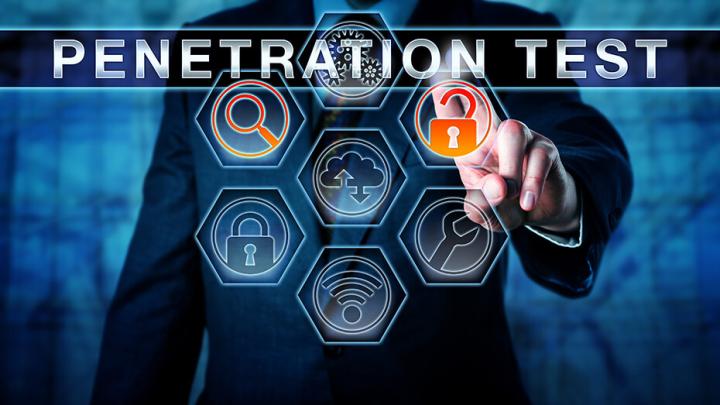In its 2025 Leadership Compass for Attack Surface Management, KuppingerCole ranks Bitsight as a top performer in product strength, innovation, and market impact. Find out why Bitsight stands apart in a crowded field of vendors—and what that means for your security strategy.
7 Types of Penetration Testing: Which Is Right for Your Business?
Tags:

What is a penetration test?
A penetration test (a.k.a. pen test) is a point-in-time cyber risk assessment. They allow IT and security professionals to assess the adequacy of security controls, including intrusion detection and response systems, and identify weaknesses that need attention.
Pen tests simulate real-world attacks in a controlled setting in order to uncover vulnerabilities in a manner that won’t actually harm your network or expose data. These vulnerabilities could arise from a number of different sources, including unpatched software, coding errors, and weak or default passwords. All this and more can be uncovered during pen testing. Put another way, a pen test is ethical hacking designed to improve protection against attacks. Unlike automated vulnerability scans, penetration tests provide a deeper, hands-on assessment of your security defenses by attempting to exploit weaknesses, just as a real attacker might.
What are the types of penetration testing, how do they work, and which is right for your business?
What is the objective of a pen test?
The ultimate goal of penetration testing in cybersecurity is to uncover and remediate vulnerabilities before malicious actors can exploit them. This proactive approach not only strengthens your organization’s defenses but also ensures compliance with security standards and builds trust with stakeholders. Pen tests aim to achieve three things:
- Identify potential breach sites and vulnerabilities through footprint analysis
- Simulate cyber attacks by penetrating vulnerable systems, applications, and services using both manual and automated tools
- Gain access to sensitive data and/or systems
Penetration testing categories
Penetration testing isn’t a one-size-fits-all solution. Tests can be tailored for a variety of products, needs, and situations. Before choosing a vendor, determine which approach will be most effective for you. Most vendors will also provide prospective clients with a questionnaire to see which test meets their specific needs.
Determine which category of pen test you need:
- Black box tests are performed with no prior knowledge of the tested network ecosystem. A black box test is an objective assessment of security as seen from outside the network by third parties and is particularly effective in external network penetration testing. Testers rely solely on publicly available information and reconnaissance techniques. It’s a test of software security operations, versus a white box test (which is structural).
- Examples of black box testing include functional testing, non-functional testing, and regression testing. However, a standard black box test likely wouldn’t involve a tactic like a denial-of-service (DoS) attack, which could cause severe damage to the network.
- White box tests are performed with full knowledge of the internal design and structure of the tested ecosystem.
- White box testing is used to logic test software for gaps in code and security, instead of behavior testing against malicious outside agents. Path testing, loop testing, and condition testing are all white box.
- Grey box tests combine aspects of white and black box testing into one. For this variety of test, experts will assess the level of software security seen by a legitimate user with an account.
- These tests give access to the software or product, along with general information about the internal ecosystem. They combine operational testing from a third party perspective with a more advanced internal understanding of the software.
How to choose the right type of penetration testing
When deciding on a penetration test, consider the following factors:
- Business objectives: What are you trying to protect? For example, customer data, intellectual property, or operational uptime.
- Regulatory requirements: Are you required to perform specific types of tests to meet compliance standards?
- Risk tolerance: How critical are potential vulnerabilities to your operations?
- Available resources: Consider your budget, time constraints, and the expertise of your internal team.
Selecting the right approach to testing is essential for success. A white box test may uncover where a developer accidentally left credentials in the software code, but be wholly inadequate to uncover vulnerabilities in open ports or third-party integrations. Learn how security ratings can help benchmark your security performance against industry peers. Working with a reputable penetration testing provider is key. Look for providers with relevant certifications (e.g., OSCP, CEH, or CREST) and experience in your industry.
What are the 7 types of pen tests?
Pen tests can be tailored to search for vulnerabilities in web apps, mobile devices, and wireless networks. The type of test you choose will depend on your organization’s unique needs, goals, and risk profile. Each type of testing can also be categorized into one of three approaches—black box, white box, or grey box testing—which determine the level of information provided to the testers:
1. Network Penetration Testing (2 types)
What is it? A network penetration test, or network pen test, is a simulated cyberattack against an organization’s IT infrastructure. It’s designed to identify and exploit vulnerabilities in network systems—such as servers, routers, switches, firewalls, and connected endpoints—to determine how a real attacker might gain unauthorized access or cause harm. Network penetration testing helps organizations uncover weak points before they can be exploited and is a critical part of a proactive cybersecurity strategy.
- External network pen test: External network penetration testing focuses on simulating attacks from outside the organization’s firewall—essentially acting like a hacker on the internet. This is a black box test designed to use footprint analysis to identify publicly available information about the network and organization, including IP addresses, ranges, and key personal information (email addresses, passwords, etc.) Using this information, an expert will locate potential vulnerabilities.
- Internal network pen test: Internal network penetration testing is a white or grey box test that simulates what an attacker could do after gaining access to the internal environment—either through a compromised device or a malicious insider. This test evaluates lateral movement, privilege escalation, and data exfiltration risks inside the network.
2. Application Penetration Testing
- What is it? Examines web, mobile, and cloud applications for security flaws like injection attacks, broken authentication, and insecure APIs.
- Approach: Can be conducted as white box, grey box, or black box testing depending on the application's complexity and the level of access provided.
- Use Case: Crucial for businesses that rely heavily on customer-facing applications or process sensitive data online.
3. Social Engineering Penetration Testing
- What is it? Evaluates the human element of security by attempting to manipulate employees into revealing sensitive information.
- Approach: Typically a black box test to mimic real-world scenarios without prior knowledge of employee behavior.
- Use Case: Effective for organizations looking to strengthen security awareness among employees.
4. Physical Penetration Testing
- What is it? Assesses the security of physical access controls, such as locks, badges, and security cameras.
- Approach: Performed as a black box test to simulate an outsider attempting to breach physical security measures.
- Use Case: Necessary for businesses with sensitive on-premises operations, such as data centers or research facilities.
5. Wireless Penetration Testing
- What is it? Examines wireless networks for vulnerabilities like weak encryption or rogue access points.
- Approach: Typically a grey box test, where testers might have some knowledge of network configurations.
- Use Case: Suitable for organizations with extensive Wi-Fi networks.
6. Cloud Penetration Testing
- What is it? Tests the security of cloud-based assets, including storage, applications, and configurations.
- Approach: Usually conducted as a white box or grey box test, as cloud environments often require specific access and permissions.
- Use Case: Essential for businesses heavily invested in cloud infrastructure.
7. Red Team vs. Blue Team Exercises
- What is it? Simulates advanced persistent threats (APTs) by pitting ethical hackers (Red Team) against your security operations team (Blue Team).
- Approach: Often involves a grey box methodology to balance realism with the need for actionable insights.
- Use Case: Ideal for organizations aiming to enhance their detection and response capabilities.
The importance of penetration testing in cybersecurity
Penetration testing is an essential component of any robust cybersecurity strategy. It allows businesses to:
- Identify vulnerabilities: Gain a clear understanding of exploitable weaknesses in your systems.
- Assess security controls: Evaluate the effectiveness of current security measures and policies.
- Demonstrate compliance: Meet regulatory and industry-specific standards such as PCI DSS, HIPAA, or ISO 27001.
- Mitigate risks: Prioritize remediation efforts based on the likelihood and impact of discovered vulnerabilities.
- Enhance incident response: Train teams on how to respond effectively to real-world threats.
Staying one step ahead of attackers is a constant challenge. Penetration testing—whether focused on networks, applications, or human behavior—is a vital part of this effort. By understanding what penetration testing is and leveraging the right type for your business, you can significantly improve your organization’s security posture, ensure compliance, and protect your most critical assets.
Penetration testing FAQs
What is penetration testing in network security?
Penetration testing in network security involves ethically hacking into a network to find and fix security flaws. It mimics the tactics of real-world attackers, testing everything from open ports to misconfigured services. The goal is to evaluate how well existing security measures hold up under attack and to provide actionable insights for reducing risk. This practice is essential for maintaining strong defense-in-depth strategies.
How to conduct a comprehensive network penetration test?
Conducting a comprehensive network penetration test involves several key steps:
- Scoping: Define objectives, assets, and authorized boundaries.
- Reconnaissance: Gather information about the network and its systems.
- Scanning: Identify live hosts, open ports, and services.
- Exploitation: Attempt to gain access by leveraging known vulnerabilities.
- Post-exploitation: Assess what sensitive data or systems can be accessed.
- Reporting: Document findings, risk levels, and remediation recommendations.
These stages help ensure a structured and ethical approach to identifying network vulnerabilities. A robust test should include both external and internal network penetration testing to give a full picture of the organization’s security posture.
What is the scope of a penetration test?
The scope of a penetration test defines what will and won’t be tested. It includes network ranges, systems, applications, and testing boundaries. A well-defined scope ensures that the test aligns with business goals, avoids unintended disruption, and focuses on the most critical assets—whether that means external, internal, or application-level penetration testing. Proper scoping also clarifies the depth and techniques allowed, such as black box, white box, or gray box testing.
What is a penetration test report?
A penetration test report is the final deliverable from a pen test. It documents the methods used, vulnerabilities discovered, risk ratings, and suggested remediation steps. A strong report translates technical findings into business risk terms, helping security leaders prioritize fixes and demonstrate progress to stakeholders. It also supports regulatory compliance and informs future security investments.
Why do a penetration test?
Organizations perform penetration testing to uncover vulnerabilities before attackers do. It helps validate security controls, measure risk exposure, and meet compliance requirements. Whether testing for internet-facing weaknesses through external network penetration testing or simulating insider threats with internal network penetration testing, a pen test is an essential tool for managing cyber risk and strengthening your organization’s resilience.
Supplementing point-in-time testing
Pen tests give you a snapshot of your security posture at a certain point in time. Between tests, the landscape can change significantly. New tools and tactics are always in development. How do you stay vigilant enough to prevent breaches, or know when you’ve been breached?
Security performance management can help bolster your defenses in between pen tests. This software combs through a wealth of globally available data to find evidence of breaches, threats, and more. Security performance management software requires a lot of data to get a holistic picture of your cybersecurity. The more data the provider can access, the better. Bitsight has access to the largest silo of data on the market.
Beyond pen-testing, continuous monitoring is an important supplemental action to monitor for suspicious activity and detect threats. Bitsight's powerful data and analytics platform continuously monitors for unknown vulnerabilities and immediately and automatically identifies gaps in your security controls.
In addition, Bitsight uses security ratings to help create advanced security benchmarking, which can be used to compare your current security standing against industry peers and historical performance. Bitsight security ratings are unique in how they correlate to performance — companies with a security rating of 500 or lower are nearly five times more likely to have a breach than those with a rating of 700 or higher.



